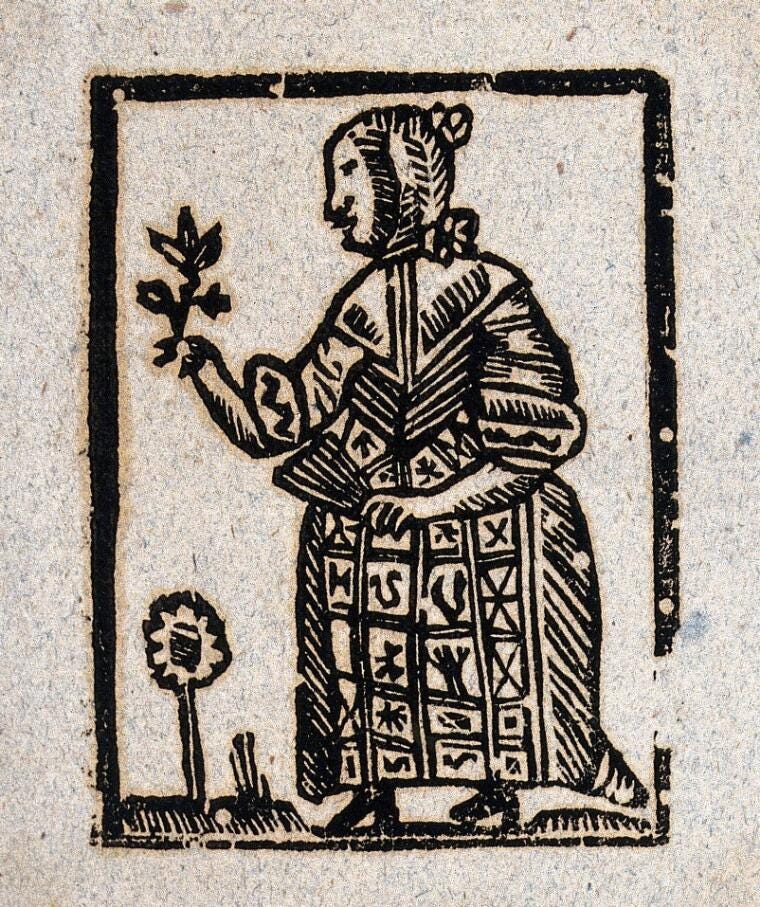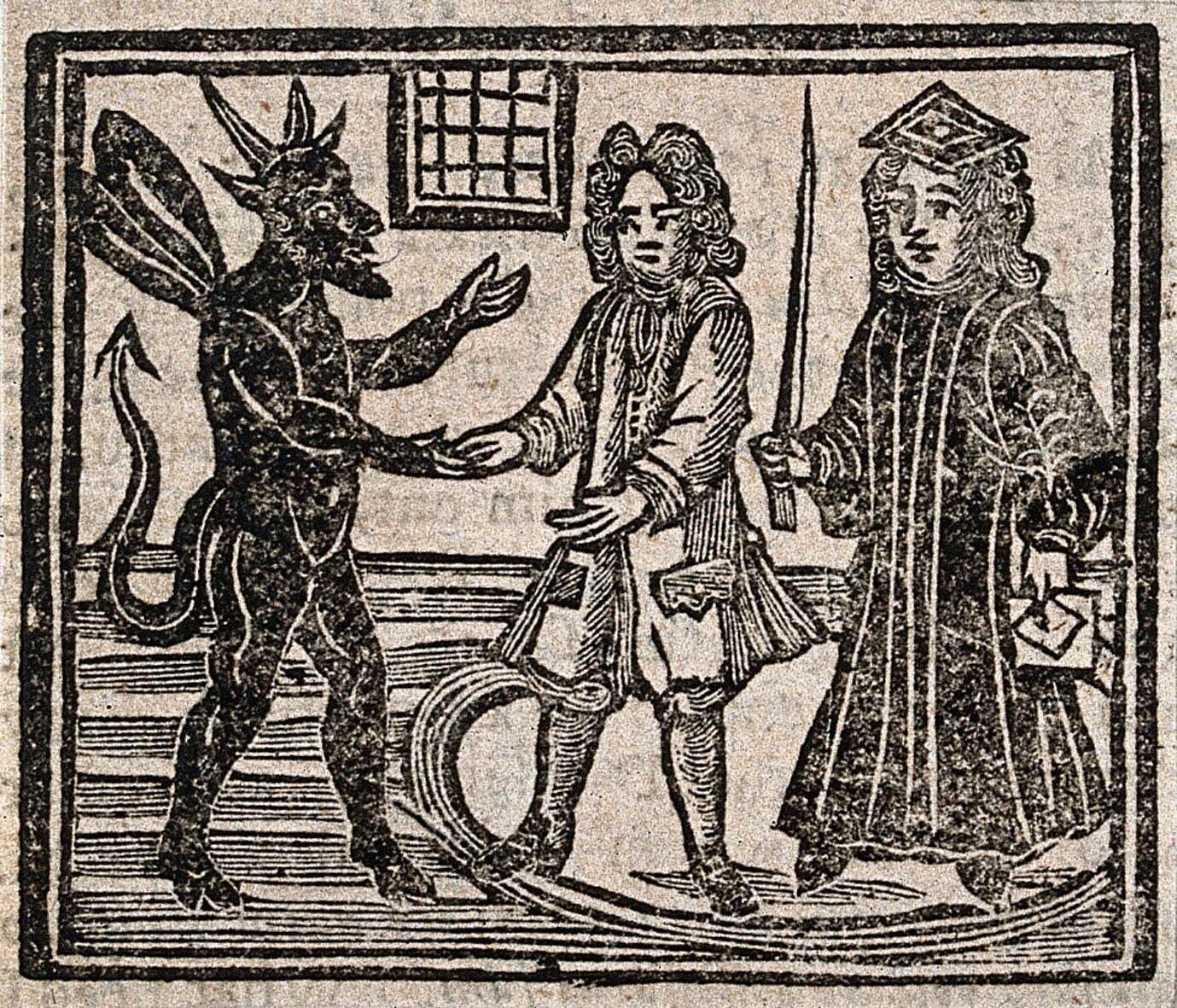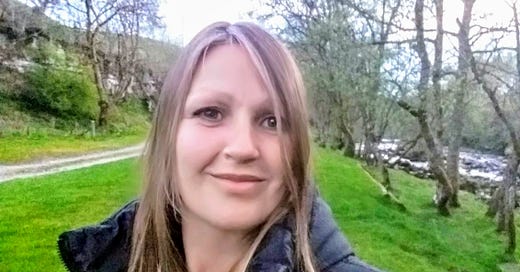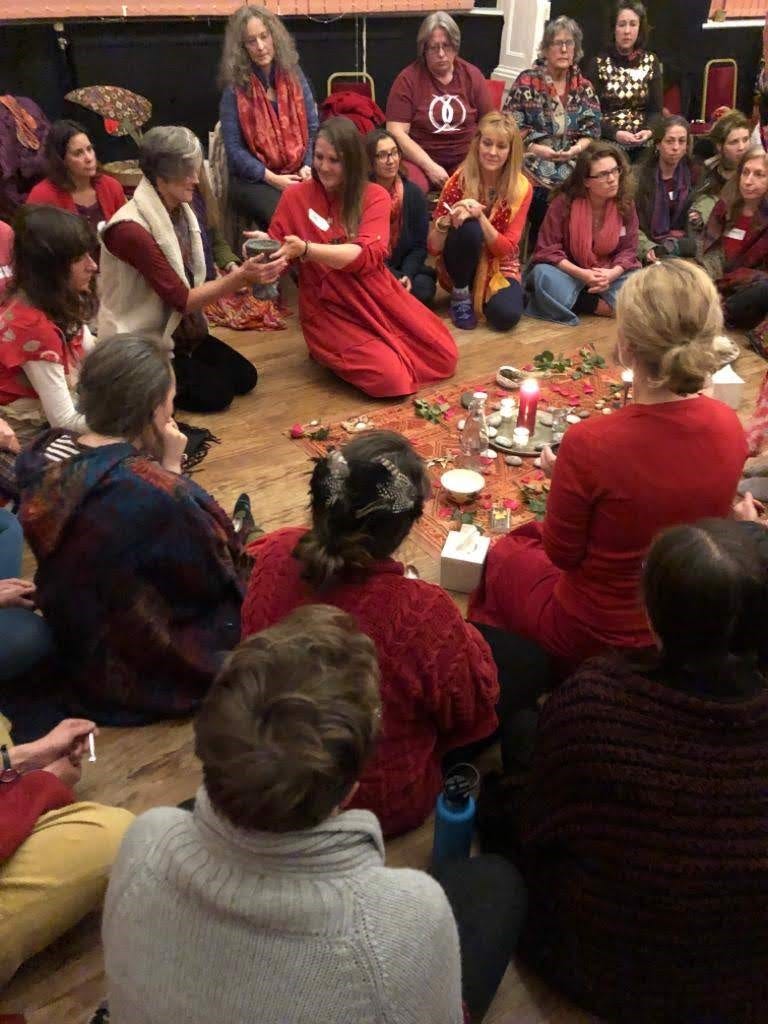The Restoration of the Sisterhood, Part I
How Cali White began her remarkable mission to integrate the tragic legacy of Britain's witch hunts.
Resonant World #19
A little over a year ago, Cali White and her Silver Spoons Collective staged a month-long exhibition in the northern English city of Lancaster dedicated to the memory of the victims of the witch trials of the early modern era.
At first, footfall at “I Am Witch” was light. But news of the event spread quickly by word of mouth, and by the final week more than 250 visitors were thronging through the doors each day, and Cali was fielding interview requests from national media.
I don’t know quite why, but now feels like an important moment to revisit the exhibition’s legacy — and the extraordinary story of its conception.
My impulse might be linked to the last in-person retreat with Thomas Hübl in Germany in November, part of a two-year training I’m pursuing in individual, ancestral and collective trauma. There I’d witnessed participants coming into contact with the legacies of many forms of collective trauma: The Holocaust; slavery and racism; World War Two; political persecution in South America; long histories of oppression in the Soviet Union and eastern Europe, and the impact of COVID-19, to name a few. With these historical and present-day processes still so alive in the room, I wondered how far back the roots of collective trauma might be traced — or how far they might reach into the future.
“Rich in Psychic Ability”
There was perhaps a deeper dimension to my impulse to seek entry points to these questions via the time of the witch hunts. For three days at the retreat, we had divided into discrete groups of about 60 men and 120 women to work on our paternal and maternal lineages. My perception was that this had catalyzed a deep recalibration of the dynamics in the group — and opened more space for all of us to sense into the different ways collective trauma could manifest across gender lines. Though I don’t recall the witch hunts ever being explicitly mentioned in the processes I witnessed, it may have been that this deepening of the collective field somehow brought this dim and distant era closer to the edge of my awareness. Or maybe this is just all in my head.
Be that as it may, a few weeks later I was struck by a section in a book I was reading — Ecology of Souls, by Joshua Cutchin, which elaborates a framework to reconcile a wide diversity of paranormal phenomenon. Cutchin recounts how Russian healer Eugene Kolessov attempted to explain the Soviet intelligence apparatus’ readiness to accept psi phenomenon to French ufologist Jacques Vallee by drawing a contrast to the Western church’s persecution of witches:
“We have done many bad things in Russia, but we have never hunted down witches on such a scale,” Kolessov said. “Our gene pool is still rich in psychic ability.”1
The credibility of Kolessov’s statement was somewhat diminished by his assertion that more than three million witches had been killed. In fact, historians estimate that some 30,000-60,000 people were executed during the era of witch persecutions across Europe.2 Nevertheless, the Russian’s broad point — that the witch hunts might have cost society in ways we can scarcely imagine — seemed somehow salient, at least in my imagination. And seeking answers in unusual places— or at least, walking the questions — is the mission of Resonant World.

Victim and Persecutor
I contacted Cali at the start of this year after stumbling across an online story in the Guardian about her exhibition. I was delighted to discover that we’d connected before — only in different guises, when I had been working as climate correspondent at Reuters, and she had been working with the amazing reforestation nonprofit Tree Sisters. Over the course of a couple of long conversations over Zoom, Cali shared more about how the Burning Times3 — as she knew them — had seemed to call to her; her understanding of how the imprint of the witch trials lives on, and her work to allow this legacy to heal.
I’d known little of the history. In England, some 500 people were executed for witchcraft in the 16th and 17th centuries, usually by hanging.4 In Scotland, which had a much smaller population, researchers have identified 3,837 people who were accused of witchcraft, of whom some two-thirds were executed, and their bodies burned.5 Confessions were often extracted by torture.
Despite this grisly backdrop, I loved our conversations, sensing that Cali was speaking from a highly integrated place, hard-won through years of inner work and service to women, many of whom had carried significant trauma. I was particularly inspired by how she had found the courage to follow her inner guidance, which led her on an incredible journey across Britain and Ireland, holding ceremonies every full moon in remembrance of the accused. Her intent was to both bring healing to women’s ancestral lineages, and to explore the lingering shadows of this shared history. The pilgrimage would ultimately pave the way for the “I Am Witch” exhibition, and the national conversation it sparked.
I also respected the complexity Cali held: Though women undoubtedly suffered disproportionately, some 6,000 men were executed for witchcraft during the years of witch persecution across Europe — 10-15 percent of the total6. (In some Scandinavian countries, a majority of the accused were men). Cali was by no means seeking to perpetuate a story of female victimhood: She wanted to understand how society as a whole might still be suffering from the legacy of the witch trials, and how that might be addressed.
“I probably had ancestors who were the accusers, or even the hangman, ” Cali told me. “Seeing this can open the door into the reality that maybe I’m not just the victim, I also have the potential to hold the persecutor's energies too. It’s been healing to explore how both sides of the dynamic show up in me.”
It felt to me that Cali’s journey was far from over: Her commitment to write a book, and her vision for an experiential museum to properly commemorate the victims of the witch trials in the British Isles, while exploring collective trauma and healing, seemed vibrantly alive.
I offer Cali’s story in the spirit of shared exploration — and to honour the connections she is weaving between women today, and across time.
“Bigger than Me”
It began back in 2017, when Cali’s marriage came to an abrupt end.
She was by then already deeply immersed in various healing practices — having spent the first part of her career in the corporate world, then retrained as a psychotherapist. A lot of her personal work had been on the root trauma of being separated from her birth mother when she was adopted.
“I went into psychotherapy thinking I wanted to help other people but very quickly realised it was because I needed the healing for myself.”
The marriage breakup, combined with the onset of menopause, marked a new phase in her self-healing process. With no children or nine-to-five job to attend, she decided to devote a year to consciously embracing this powerful female rite of passage and to follow the new threads that would emerge.
“In the beginning old and painful traumas would surface and I had this feeling of: Is this never going to end? Am I always going to feel this way? There was this fear of speaking up; the never feeling settled; the not being able to kind of get any traction with my work. I was running women’s groups and self-development programmes which always went really well, but I just couldn’t seem to get to making a sustainable living out of it. There was so much fear in me to put my work out there and be seen. Menopause was a gift of properly being able to just stop and sit with stuff, to really face into myself. And it started to dawn on me, maybe this isn’t all mine? Maybe this is more than me, maybe this is bigger than me?”
Cali knew she was not alone in her fear and emotional struggles: So many of the women she’d worked with in women’s circles described the same anxiety about stepping fully into their power, and how they felt compelled to compromise, or play small, or struggled to ask for help or receive support. Years earlier she’d read about Carl Jung’s theories of the collective unconscious, but up until then they had felt very abstract and intellectual. Now, however, she began to experience more of a felt-sense that there might be some deeper dimension to what she was experiencing herself, and observing in so many others — and this felt like an important new thread to follow.
As did the call of her ancestors. Having studied Earth-based medicine traditions and undergone vision quests for years, Cali, who grew up in Newcastle, had begun to explore her indigenous roots through ancestral healing work. She felt an impulse to go deeper, travelling from her then home in West Sussex to attend a six-month practitioners training course in London, seeking a sense of “home” that she had never managed to establish growing up.
“It was something about belonging: Part of the adoption wound had left me with a perpetual sense of being uprooted and it was this wound that became perhaps the biggest gift of my life.”
The ancestral work ignited a new interest in history — and a passion to trace her ancestral timeline back through waves of colonisation by Normans, Vikings, Angles, Saxons and Romans, to the Neolithic times of stone circles and longbarrows. History had lacked any meaningful context at school, but suddenly came alive as she began to search for a sense of her own roots in the deep past. But it was learning about the 300-year era of the witch hunts that seemed to switch on a light.

Lifting the Veil
As part of her research, Cali read Caliban and the Witch by Silvia Federici, a Marxist-feminist scholar who argues that the witch hunts helped to violently transform a system of female-led, natural healing into the male-dominated, empirical model of medical science.7 And she began to learn more about studies of epigenetics that suggest trauma can create biological markers that cascade through generations.
Cali was also practicing daily drumming to connect with her ancestors via shamanic journeying, as she honed her practice as a healer — seeking to build a bridge between modern, scientific knowledge and older forms of spirituality.
“As I’m doing my research, my ancestors from those times started to flood into my journeys. They would show me what had happened to them during their lives, their loves and losses, their pain and suffering, and then I would come out of the journey, and I was somatically feeling and needing to feel and process what they hadn’t been able to.
“Sometimes it was grief, sometimes it was rage, sometimes it was terror.
“And because of the training I’d done before, I was able to just let my body take over and do what it needed to do. So I would sob, I would rage, I would stomp around, I would curl up in a ball. Sometimes they needed me to go and hold ceremony for them, to make offerings, to hold forgiveness rituals to complete processes. So I was kind of doing all this work and what I noticed was the more that I did, the clearer I felt, body, mind and spirit.
“It was like this veil being lifted. It was like the Wizard of Oz, where it goes from black and white into Technicolor. ‘Oh, there’s Life! I can see Life now!’ The more I connected to my ancestors, the more I started feeling supported. And the more I started to get a sense of what’s next in my life. It was an incredible time of insight, of healing, of awareness, of understanding.
“I’d cleared tonnes of grief, I’d cleared loads of rage, and anger, and then I got to the fear, to the terror. And I said okay: ‘How do I do that? How do I really get over that?’ And the answer, was like an instruction: You’re going to give up everything that you think you know as safety, as home. You’re going to travel around the UK and Ireland and every full moon, gather women and hold ceremony for the ancestors of the Burning Times.
“For me that was facing my own fears, of giving up any kind of safety, and taking something out into the world that was my own, that had come through me.”
It was the start of a magical year that would see Cali hold 13 full moon ceremonies and 20 workshops for 600 women — tapping into a powerful collective desire to reckon with the legacy of the past — and change the course of the future.
Next Week: Cali explains her understanding of how the wounds of the witch persecutions continue to show up in women; how that plays out in society, and how the exhibition provided a focal point for a form of collective healing.
Thank you for reading Resonant World. I write this newsletter in my spare time from my job as an editor at nonprofit climate news service DeSmog. Buying me a coffee provides fuel for in-depth conversations that I then serve up — much like fresh coffee — for your delectation and refreshment. Thank you to all those who’ve generously donated — and to everyone who is reading, commenting on, and sharing Resonant World!
Cutchin, Joshua. (2022) Ecology of Souls: Volume One, A New Mythology of Death & The Paranormal. Joshua Cutchin. Horse and Barrel Press, 2022. P. 253.
Witchcraft: Eight Myths and Misconceptions, English Heritage.
According to the English Heritage Witchcraft: Eight Myths and Misconceptions, witchcraft was a felony in both England and American colonies, so witches were hanged — not burned at the stake. However, witches’ bodies were burned in Scotland, which accounted for the majority of witch executions that took place in the British Isles.
Witchcraft, a web page on the site of the UK Parliament.
The Survey of Scottish Witchcraft. School of History and Classics, the University of Edinburgh.
Ibid.
I would love to have found time to read this book, and many others on this topic. Suffice to say that the history of witchcraft can be interpreted through different lenses, and I’m not qualified to comment on the validity of one school versus another.







I've got goose pimples now and by the end of the writing I felt like sobbing as if there were no tomorrow.
Thank you Cali, thank you Matthew 🙏.
I look forward to the next part.
Huge gratitude to you Matthew, for sharing with us Cali’s amazing work and healing journey. I was shivering and trembling while reading. I could’nt stop. I’ve written to her.
Thank you Cali for opening such a door in my body, and for being so inspiring 🙏
This is such a deep Call ! I stay with that : « If we want to collectively reclaim our psychic abilities, we need heal that collective trauma ».
Yes, we do 😥